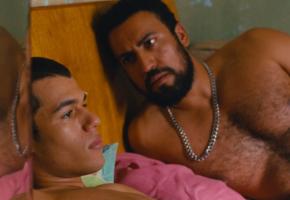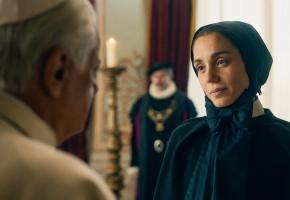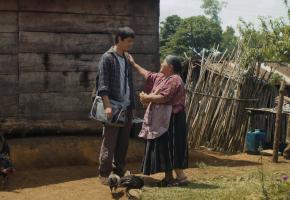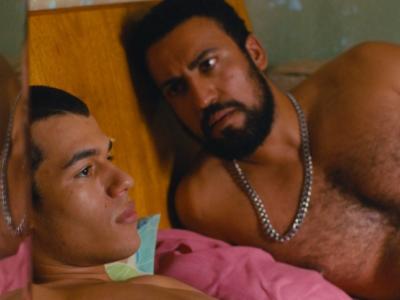Story-telling comes naturally to Martin Kraut. Since he was a child at primary school, he was already writing at every opportunity. He even developed a script at the time, although it was not until he was at secondary school that he began to actually study film. Eventually, he graduated in Film Directing from the FUC Universidad del Cine: -
“I also started to study photography [at the Escuela Argentina de Fotografía ] because I was drawn to images, although, in parallel, I was always writing and telling stories… It was when I started at the Film workshop in my teens, that I realised that ‘film’ united my two deepest passions: to tell stories and to use images at the same time… I never was the typical cinephile…it came as the natural result of uniting my two favourite passions.”
In 2010, Kraut visited Cuba. “I spent a month absorbing the local culture that I’m very interested in, and I say this because in my first short film (Que Miren 2010) I used a lot of ‘boleros’ [in the sound track] many from Cuba, but I also visited the Cuban Film school that really inspired me to try my hand at filming”

Julia Martínez Rubio and Arturo Bonín in Que Miren (2010)
Being fascinated by the challenge of working on adaptations, for his first short film “Que Miren” (2010) Kraut chose a short story of Raymond Carver: ‘Why Don’t you Dance.’
“There’s always been something about the imaginary world of Raymond Carver that I love, so that’s why I chose to do this [particular] adaptation. It was also interesting as an exercise, to create an authentic adaptation, rather than be too strictly faithful to the original text. I also wanted to introduce something of the world of Edward Hopper’s paintings, that I like enormously. I feel that Carver and Hopper, each in their own way with their different disciplines, describe similar worlds of solitude and isolation, with the beauty that emerges from capturing small moments and I felt that they complemented each other. Because the deepest solitude can be felt not when you are alone, but when you are accompanied, which that can be so much worse.”
The short was filmed on a breath and a prayer, produced by himself. He spent some time looking for the actors, a difficult task, as no one was to be paid. He watched many theatrical plays and had many recommendations and was fortunate enough to find Julia Martínez Rubio and Arturo Bonín: -
“Julia Martínez Rubio was marvellous! It’s so wonderful when you feel that an actor’s performance surpasses so much more than you could have imagined as they incarnate the character that you have created. Arturo Bonín is very well known, he’s had an amazing career and above all, he’s a great person. In the very first meeting I had with him and, when you think it was for an insignificant short film with no funds… no one was paid…he told me how he felt that the mission of his generation was to do what they could to help the new generations develop and go forward. So, he joined us and was just like everyone else. He ate what we ate, travelled in the same way and even urinated in the same loo, the chemical loo that we’d rented!”
Full Movie Que Miren (2010) 16 min
Another problem that faced Martin Kraut on that short film was the location. The story demanded an open front lawn area where a ‘garage sale’ American style, could be held. There are no such front gardens in Buenos Aires. Most are closed with hedges, fences, walls or even bars of some sort. So, he had to go to an area on the outskirts of the city, where there are gated communities. One such place was ‘Ciudad Jardin’ (Garden City). The story of ‘Que Miren’ explores how intimacy can be all too visible, affected by the power of music and the alienation between individuals. Kraut landed in this area and started to ring doorbells, and more doorbells.
“We ended up with an elderly lady who owned the place where we finally shot the movie. At one point she said: ‘You know, my son also works in films’… ‘Oh, really’, I replied … ‘What’s his name?’ … to which she replied: ‘Gustavo Santaolalla!’ Now he is a truly extraordinary musician, who has won two Oscars for original scores. He’s mega, mega famous, and this incredible woman Orfelia Santaolalla was his mother. So that was Santaolalla’s childhood home! That’s how we ended up shooting the film there, a place that she lent to us with amazing love. An incredible woman, who at that time was 92 years old. Sadly, she has since died, but she was wonderful.”
This was an extraordinary coincidence as Gustavo Santaolalla is indeed a mega star. He won Academy Awards for Best Original Score for two consecutive years, with Ang Lee’s Brokeback Mountain (2005) with Heath Ledger and Jake Gyllenhaal, followed by Alejandro G. Iñárritu’s Babel (2006)with Brad Pitt, Cate Blanchett and Gaël García Bernal. Santaolalla has also written his beautiful, haunting music to so many of our favourite films. These include ‘The Insider’ with Al Pacino & Russell Crowe, Iñárritu’s ‘21Grams’ (2003) with Benicio del Toro, Naomi Watts and Sean Penn, ‘Amores Perros’ (2000) also directed by Iñárritu and more recently, the music to a very popular Sony Play Station video game ‘The Last of Us’. Have a listen: https://youtu.be/GIxEksteSgo
So clearly this was a good omen for Martin Kraut and the resulting short film ‘Que miren’ is sensitively crafted. It was a success and opened many doors and Kraut emphasizes it was a treat to shoot a story that he found so absorbing and interesting.

Poster for La Dosis (2020)
As previously mentioned, La Dosis (2020) was inspired by a report that Martín Kraut read in a newspaper: -
“Suddenly I came across a report from Uruguay about two nurses accused of killing their patients. In the case of one, through compassion, but for the other, the motives were a lot more doubtful. They confessed and for me, what stood out and gave me the kernel for a film, was that there were two of them… there was a play between the two, you could say a rivalry or even a friendship. What took place in the actual case was not that clear. In the end, nothing could be proved, not even that the patient’s deaths were caused by their actions, so they were released as free men. No one could prove their guilt nor sentence them. Initially that was a shock for me as I had become trapped by the real story, but at the same time, it freed me to create a new path and my own story based on that premise …in the end, was good for me, because in some cases, reality surpasses fiction and that’s not always the story you want to tell! So, I chose my own path and my own story and ended up working on it for many years”.
Read the film review of The Dose (La Dosis)
https://www.latinolife.co.uk/articles/dose-la-dosis-2020-thriller-argen…

Filming La Dosis with Carlos Portaluppi
‘La Dosis’ is full of suspense and creeping horror. Marcos Roldán is a night nurse in the Intensive Care Unit with 20 years’ experience. He harbours a secret of quietly helping some of his patients on their way, with compassion and genuine concern. But everything changes when a young, charismatic male nurse Gabriel, turns up on the ward. He is manipulative and uses charm to get his way, but Marcos immediately susses that this person cannot be trusted and when he finds out that Gabriel is also ending lives, but with very different motives, he realizes that to expose him could be putting his own life on the line.
Carlos Portaluppi and Martín Kraut
Kraut developed the idea at script workshops and eventually decided to present it to the Argentine Film Institute for their ‘Opera Prima’ competition. This competition is designed to foment and encourage the film industry by attracting new talent. It turned out to be a wise move.
“Generally, it’s very difficult [to make a first film]because raising funds for an opera prima, without a well-known director and what that implies, is very hard, given that film-making is so expensive. I therefore consider myself very fortunate at having won this competition, as they subsidised 100 % of the cost of the film.”

Carlos Portaluppi and Ignacio Rogers
‘La Dosis’ has been doing the festival rounds during 2020, but unfortunately the absence of live audiences limited the debate that this film generated. There were many virtual Q & As, and discussions that appeared in various journalist’s reviews, but inevitably, given the pandemic, not to the level that Martin Kraut and his producer Pablo Chernov would have liked.
“Here [in Buenos Aires], we conducted an online event, bringing together specialists on the Euthanasia issue, [including] lawyers and doctors, we even had a sort of forum, so the film became the excuse to discuss and debate these themes, which was also partly my intention for this film… that is… to open a debate, to open a door so that these issues are discussed because … as you know… there are very few countries where euthanasia is totally legal, although there are some where it is partially allowed. Here, in Argentina, I think we are very, very, very far from that, in effect, we have only just legalized abortion … I mention abortion because I believe we have entered a time when we have begun to discuss issues relative to the rights an individual has over their own body, and in many ways, euthanasia also represents those rights.”

Martin Kraut and crew on La Dosis
The logistics of the production were many, in particular the search for a suitable location, It was clear from the outset that it would be impossible to film in an actual hospital, as no ICU unit could be closed for 2 or 3 weeks for filming. The aesthetics were also important, as Kraut was adamant that he wanted a place with certain distinctive characteristics: -
“It was important for me to find a ward that had a circular feel, a pan-optical view from where the nurses could see everything that was going on. [Today] more and more ICU beds are actually isolated… Eventually we ended up filming in a hospital 95% of which is now abandoned. It is the Israelite Hospital in Buenos Aires.”
On one side, this was very sad as Kraut’s own grandfather died in that very hospital. Built and founded in the 1920s, for theJewish Community in Argentina, it is an old and impressive building. Due to unwise links with local social services, it went bankrupt in the 90s. Smalls sections have been rehabilitated by the workers themselves. With the Art Director, Juan Giribaldi, the props and set designer Julia Antún and the Director of Photography Gustavo Biazzi, Kraut worked meticulously to create the exact environment for his world, imbued with greens, blues and cold tones: -
“We worked on the atmosphere and the tones that were so important to convey that level of solitude and the alienation of that situation, The mood of the night shift was just as important and I contributed a series of references in film, for example the 2003 Korean movie ‘A Tale of Two Sisters’ by Kim Jee-Woon, that had a hospital with a similar vibe and camera movements, also ‘The Killing of a Sacred Deer’, Yorgos Lanthimos 2017 film, with Colin Farrell and Nicole Kidman’
These productions also echo the themes of fate and as in ‘The Killing of a Sacred Deer’, which, based on Euripides’ Greek tragedy, deals with cosmic punishment for human hubris, as King Agamemnon’s daughter is sacrificed by her father for his own failings.

Martín Kraut
The cast is led by Marcos Roldán, (the wonderful Carlos Portaluppi), who plays an experienced nurse who is a gentle giant, beset with doubts and the strain of moral decisions. Gabriel, (Ignacio Rogers) the new addition and counterpart, is, in turn, physically slender and delicate in build, which conceals his strong and dominant character. These two leads are like the two sides of the same coin. Carlos Portaluppi was attracted to the role, in part having had the experience of supporting his sister through long periods in intensive care units.
“In many ways the two leads are like the ying and yang of this situation, with Lorena Vega, who is a great actress, closing the triangle… the name ‘Marcos’ is a reference to the limits of his vision, and for ‘Gabriel,’ for the angelical image that he tries to portray…”
Martín Kraut is not sitting on his laurels and is busy on a new project that also questions ethical and moral issues. It will be a police thriller: -
“[It’s about] an undercover officer who infiltrates a Media Agency and it’s also based on a real-life event. There is something that interests me about the world of Intelligence Agencies, but above all, I’m attracted to a story about spies without the glamour. I want to talk about the routines of those jobs (that also relates to ‘The Dose’), and what happens to people whose jobs absorb so much of their lives, placing them in situations of isolation and where ultimately, they will doubt which is their true identity.”

Martín Kraut and producer Pablo Chernov at the premiere in Rotterdam
Credits ‘Que Miren’ (Let them Look) 2010
Freely adapted from a story by Raymond Carver
Screenplay Martin Kraut
Directed Martín Kraut
Producer Pablo Chernoc and Natali Sussman
DOP Agustín Barrutia
Sound Manuel de Andrés
Editor Valeria Racioppi
Cast Julia Martínez Rubio, Arturo Bonín and Juan Barberini
Credits ‘La Dosis’ (The Dose) 2010
Written/ Dir. Martin Kraut
Prod Pablo Chernov/ Martin Kraut
DOP Gustavo Biazzi
Editor Eliane D Katz (SAE)
Art director Juan Giribaldi
Set and Props Julia Curi Antún
Sound Design Manuel de Andrés (ASA) Tritón Sonido
Original Music Juan Tobal
Cast Carlos Portaluppi, Lorena Vega and IgnacioRogers



















